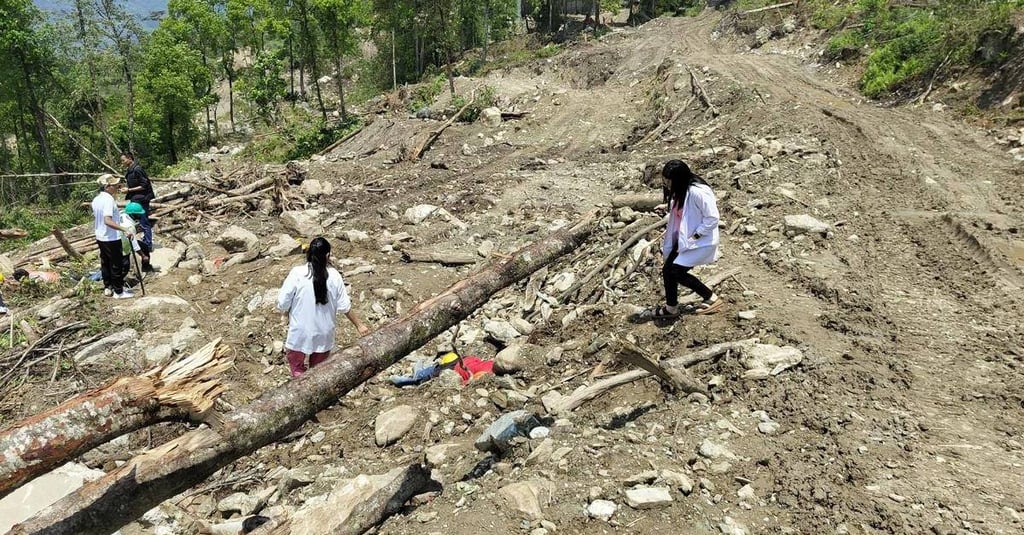Mock drill at NIT Khamdong tests disaster preparedness in Gangtok
The drill showed that Gangtok’s emergency teams are well trained and capable. However, it also pointed out some areas where more training is needed.
LOCAL


A full-scale mock drill was organised at the National Institute of Technology (NIT), Khamdong under Sang Rabdang Subdivision on Tuesday. The event was conducted by the District Disaster Management Authority (DDMA), Gangtok. This drill was designed to check how well different government departments and emergency teams can work together during natural and man-made disasters. The main aim was to find out how ready the district is to deal with real-life emergencies and to improve the speed and coordination of response teams.
The mock drill was supervised by the District Collector of Gangtok, Tushar G Nikhare who closely observed all parts of the operation. The drill followed the Incident Response System, which assigns specific responsibilities to different officers. Sisum Wangchuk Bhutia, Additional District Collector of Gangtok, served as the Responsible Officer. Roshan Subba, Sub-Divisional Magistrate of Rabdang, acted as the Incident Commander, while the Sub-Divisional Police Officer of Rabdang worked as the Operational Section Chief. All actions were taken based on this system to ensure smooth planning and coordination.
The mock drill included a series of emergency situations that could happen in real life. The first part of the drill simulated a landslide that caused trees to fall and block important roads. The Forest Department from Singtam Range was immediately deployed to clear the debris and make the road usable again. This tested how fast the teams could restore road access after a landslide.
In the next part of the exercise, a fake earthquake was created to see how people would respond during such a crisis. The focus was on safely evacuating the NIT building, searching for anyone who might be trapped, and giving first aid to the injured. The National Disaster Response Force (NDRF) 2nd Battalion was responsible for the search and rescue work, and they performed it with great discipline and care.
As the earthquake simulation continued, a fire was “triggered” at the nearby Sonamati Senior Secondary School, also known as Khamdong School. This added pressure to the teams and tested how well they could manage multiple disasters at the same time. The Fire & Emergency Services from Singtam rushed to the school and carried out the rescue and fire control operations. They were quick in responding and showed good coordination with other departments on the ground.
To make the drill more complete, a relief camp was also set up at the hostel of the same school. This part of the drill showed how affected people could be safely moved to shelters and given food, water, and medical help. The camp was managed by the Block Development Officer (BDO) of Khamdong and the Assistant Director of the Food and Civil Supplies Department. It was a practical test of how relief camps would function during a disaster.
Many government departments and local bodies took part in the drill. These included the Forest Department, Fire and Emergency Services, Health Department, Sikkim Police, NHPC, local Panchayats, and community volunteers. All these groups worked together and followed standard procedures. They carried out their duties quickly and responsibly rescuing people, clearing blocked areas, putting out fires and giving first aid where needed.
The drill showed that Gangtok’s emergency teams are well trained and capable. However, it also pointed out some areas where more training is needed. Communication during emergencies, movement during roadblocks, and handling multiple disaster events at the same time were noted as areas for improvement. The District Disaster Management Authority said that they will continue to organise more such drills so that everyone becomes better prepared.
At the end of the event, District Collector Tushar G Nikhare also spent some time with students of the Sonamati Senior Secondary School. He talked to them about the importance of disaster awareness and gave motivational advice on career choices and future planning. His interaction left a positive impression on the students, who were actively involved in the drill.
